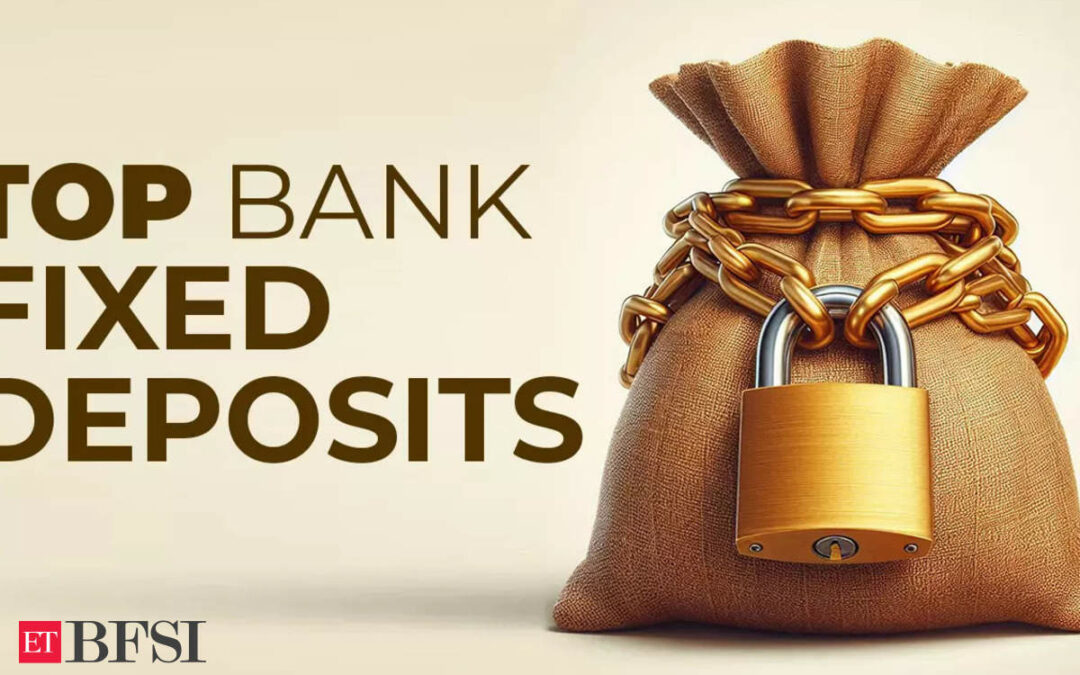Bank Fixed Deposit Rates: Which banks offer the best FD rates? Which are the top 5 bank fixed deposits? Bank Fixed deposits or FDs are a favored investment option for risk-averse investors. Financial experts suggest that the present high interest rate environment may be an ideal time to invest in fixed deposits before the RBI begins to lower rates. However, with numerous banks offering FDs, it can be challenging to determine which ones provide the best returns.
To help you make an informed decision, below is a list of the top 5 bank FDs for tenures of 1 year, 2 years, 3 years, and 5 years as provided by the ET Intelligence Group. Additionally, we provide you with an estimate of how much your investment of Rs 10,000 would grow into when invested in these fixed deposits.
Top 5 Bank Fixed Deposits:
Source: ET Intelligence Group
For the 1 year tenure, the top 5 bank FDs are from: IndusInd Bank (7.75% interest compounded quarterly, Rs 10,000 would grow to Rs 10,798), RBL Bank (7.5% interest compounded quarterly, Rs 10,000 would grow to Rs 10,771), Bandhan Bank (7.25% interest compounded quarterly, Rs 10,000 would grow to Rs 10,745), Yes Bank (7.25% interest compounded quarterly, Rs 10,000 would grow to Rs 10,745), Indian Overseas Bank (7.10% interest compounded quarterly, Rs 10,000 would grow to Rs 10,729).
For the 2 years tenure, the top 5 bank FDs are from: RBL Bank (8% interest compounded quarterly, Rs 10,000 would grow to Rs 11,717), IndusInd Bank (7.75% interest compounded quarterly, Rs 10,000 would grow to Rs 11,659), DCB Bank (7.5% interest compounded quarterly, Rs 10,000 would grow to Rs 11,602), IDFC First Bank (7.5% interest compounded quarterly, Rs 10,000 would grow to Rs 11,602), ICICI Bank (7.25% interest compounded quarterly, Rs 10,000 would grow to Rs 11,545).
For the 3 years tenure, the top 5 bank FDs are from: DCB Bank (7.55% interest compounded quarterly, Rs 10,000 would grow to Rs 12,516), RBL Bank (7.5% interest compounded quarterly, Rs 10,000 would grow to Rs 12,497), Yes Bank (7.25% interest compounded quarterly, Rs 10,000 would grow to Rs 12,405), IDFC First Bank (7.25% interest compounded quarterly, Rs 10,000 would grow to Rs 12,405), IndusInd Bank (7.25% interest compounded quarterly, Rs 10,000 would grow to Rs 12,405).
For the 5 years tenure, the top 5 bank FDs are from: DCB Bank (7.4% interest compounded quarterly, Rs 10,000 would grow to Rs 14,428), Dhanlaxmi Bank (7.25% interest compounded quarterly, Rs 10,000 would grow to Rs 14,323), IndusInd Bank (7.25% interest compounded quarterly, Rs 10,000 would grow to Rs 14,323), Yes Bank (7.25% interest compounded quarterly, Rs 10,000 would grow to Rs 14,323), RBL Bank (7.1% interest compounded quarterly, Rs 10,000 would grow to Rs 14,217).
The Reserve Bank of India (RBI) may have decided to keep the repo rate unchanged in its latest monetary policy review earlier this month, but experts believe that this could be the last pause before the central bank starts a series of interest rate cuts.
As a result, bank FD interest rates may gradually decrease in the coming months. While FD investors benefited from the rising interest rates in the past, the same investment strategy may not provide similar returns in a falling interest rate environment.
For those with extra funds or FDs that are about to mature, this could be the perfect opportunity to secure their investments at the current high interest rates. “This is an opportune moment for fixed income investors to lock-in rates at elevated levels. Considering how the case for future rates is balanced between status quo and declines, fixed rate propositions may be favoured over floaters,” advises Nirav Karkera, Head Research, Fisdom.
Experts told ET that it is expected that long-term FDs will be less affected by the initial rate cuts, while short to medium-term FDs may experience a more substantial decrease in interest rates. This means that the chances of getting better interest rates when your FD matures in the future are less likely.










